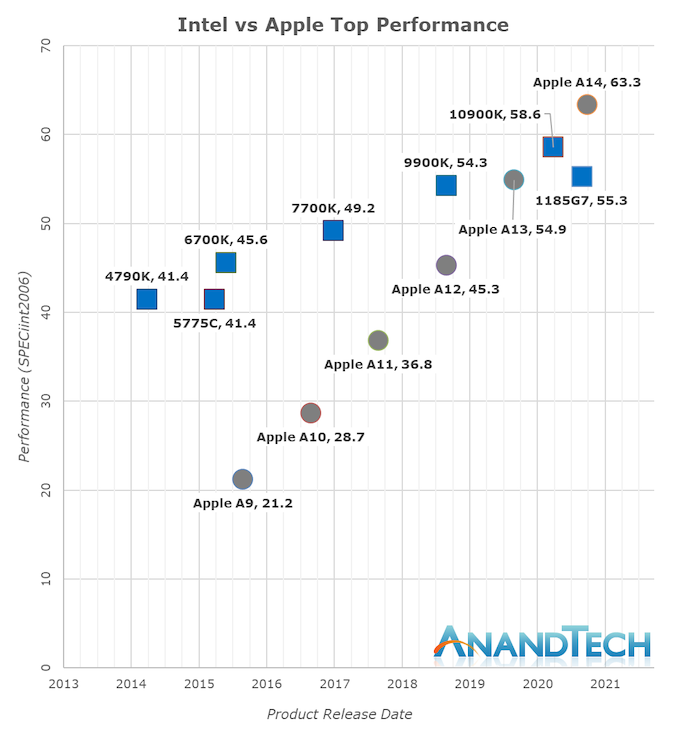Thought experiment on upcoming Apple Silicon Macs
I’m not one to put a lot of stock into rumors. Occasionally, though, one comes across that gets me thinking. This was one of them.
There’s a lot of speculation there. One of those items caught my eye, though.
A15 is aiming for 30% speed improvement.
Apple is known for having the fastest phones thanks to their own silicon. Their chip team is fantastic, making an A15 with a potential 30% speed improvement over the A14 quite likely.
What impact would this have on the Mac, though?
The M1
In November, Apple announced the first Macs with their own silicon. The M1, based on the A14 chip featured in the iPhone 12 series and the 4th generation iPad Air, quickly gained a reputation for amazing performance for the amount of power required. It scored the highest single-core score on Geekbench, and while it was beaten in multi-core, it was no slouch, either.
While the A14 has a 6 core architecture (2 performance cores, 4 efficiency cores), the M1 has an 8 core architecture. The additional 2 performance cores no doubt help bring up the M1’s multi-core score and help make the latest Macs truly fast machines.
The M1 has allowed Apple to take beloved Macs like the MacBook Air and simultaneously:
- Increase CPU performance by up to 3.5x over the previous MacBook Air
- Increase battery life by 50% (from 12 hours to 18 hours)
- Remove the fan
The MacBook Pro got similar improvements:
- Increase CPU performance by up to 2.8x over the previous MacBook Pro
- Increase battery life by 100% (from 10 hours to 20 hours)
While retaining the fan, many users report hardly ever hearing the fan in a MacBook Pro, nor feeling excessive heat from the device, even under heavy workloads.
The (Theoretical) M2
With everything Apple could bring because of the M1, what could the M2 provide? Where can our speculation start?
I’m going to start with the rumor quoted above.
If we assume the M2 will be based on the A15 chip, and we take the 30% improvement as a finality with the A15, I think we could safely assume such performance increase would come to the M2.
According to Geekbench scores, the M1 scores approximately 1700 in single-core and 7100 in multi-core. Assuming a 30% increase for the M2, I would assume that takes the single core scores above 2000 (and potentially up to 2200). Geekbench browser shows Hackintoshes with AMD Ryzen 9 5950X at that range, but I would assume these are overclocked. Regarding multi-core, assuming a more modest 20% increase (though I don’t see why 30% wouldn’t be possible), that gets the M2 up to 8500.
And an M2X?
This theoretical M2 is with the same 8 core architecture in mind. What if Apple made the M2 more than 4 performance cores?
While you can’t really just multiply your multi-core score by the number of performance cores, I’m going to do that just as a thought exercise. How close could Apple be to having their own silicon out-perform even their most expensive Mac?
First, let’s look at the current high end Macs. The (recently discontinued) iMac Pro was configurable up to an 18 core Intel Xeon W-2191B configuration. Its multi-core score is around 13,300. The Mac Pro’s base configuration is a 12 core Intel Xeon W-3235 scoring at 12,000. The highest Mac Pro configuration, with a 28 core Intel Xeon W-3275M, maxes out at just above 19,000.
Naively assuming doubling our performance core count would double our multi-core score, an M2X with 8 performance cores could potentially have a score of 17,000. That easily out performs the iMac Pro and takes us into Mac Pro territory. Should going to 8 performance cores not double our multi-core score, however, I do think an M2X would still beat out the iMac Pro easily.
Whether or not we see a Mac Pro this year with Apple Silicon, I think Apple is easily on their way and will definitely complete their 2 year transition on schedule. By the time it’s done, I feel we will see the following configurations:
- M# – 4 performance cores, 4 efficiency cores. Focused on the ‘lower end’ of the Mac spectrum (MacBook Air, Mac mini). Easily outperforming today’s Intel-based Mac portable line.
- M#X – 8 performance cores, 4 efficiency cores. Used in the MacBook Pro and iMac lines. Potentially outperforming anything up to (and maybe including) today’s Intel-based Mac Pro.
- M#Z (or some other identifier) – 12+ performance cores, 4 efficiency cores. Mac Pro option, providing amazing performance with less power consumption, easily replacing the current Mac Pro.
I was personally impressed with the M1 Macs that were announced. When it becomes time for me to get a Mac (likely with an M2), I know I will be thoroughly pleased with its performance. The Mac’s future is very bright at this point.



